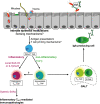Robust microbe immune recognition in the intestinal mucosa
- PMID: 33958733
- PMCID: PMC8497264
- DOI: 10.1038/s41435-021-00131-x
Robust microbe immune recognition in the intestinal mucosa
Abstract
The mammalian mucosal immune system acts as a multitasking mediator between bodily function and a vast diversity of microbial colonists. Depending on host-microbial interaction type, mucosal immune responses have distinct functions. Immunity to pathogen infection functions to limit tissue damage, clear or contain primary infection, and prevent or lower the severity of a secondary infection by conferring specific long-term adaptive immunity. Responses to nonpathogenic commensal or mutualistic microbes instead function to tolerate continuous colonization. Mucosal innate immune and epithelial cells employ a limited repertoire of innate receptors to program the adaptive immune response accordingly. Pathogen versus nonpathogen immune discrimination appears to be very robust, as most individuals successfully maintain life-long mutualism with their nonpathogenic microbiota, while mounting immune defense to pathogenic microbe infection specifically. However, the process is imperfect, which can have immunopathological consequences, but may also be exploited medically. Normally innocuous intestinal commensals in some individuals may drive serious inflammatory autoimmunity, whereas harmless vaccines can be used to fool the immune system into mounting a protective anti-pathogen immune response. In this article, we review the current knowledge on mucosal intestinal bacterial immune recognition focusing on TH17 responses and identify commonalities between intestinal pathobiont and vaccine-induced TH17 responses.
© 2021. The Author(s).
Conflict of interest statement
The author declares no competing interests.
Figures

References
Publication types
MeSH terms
LinkOut - more resources
Full Text Sources
Other Literature Sources

